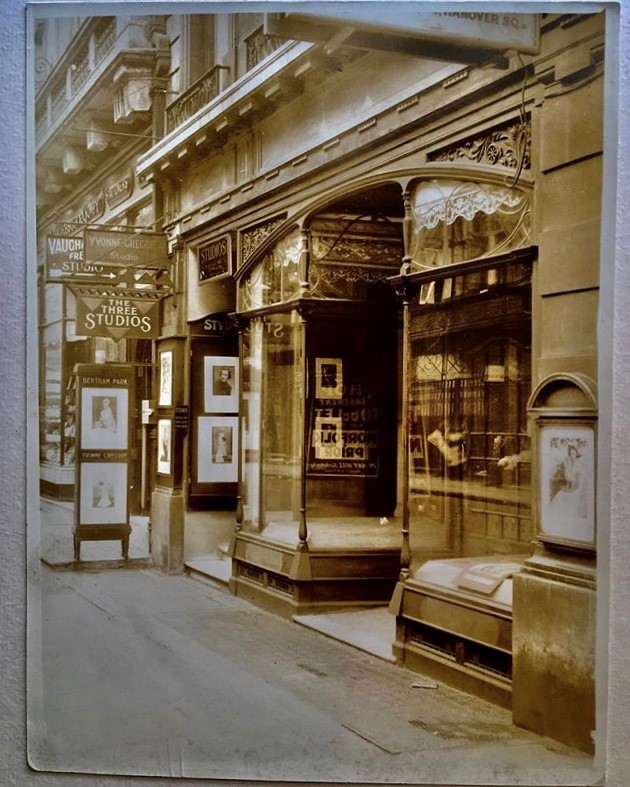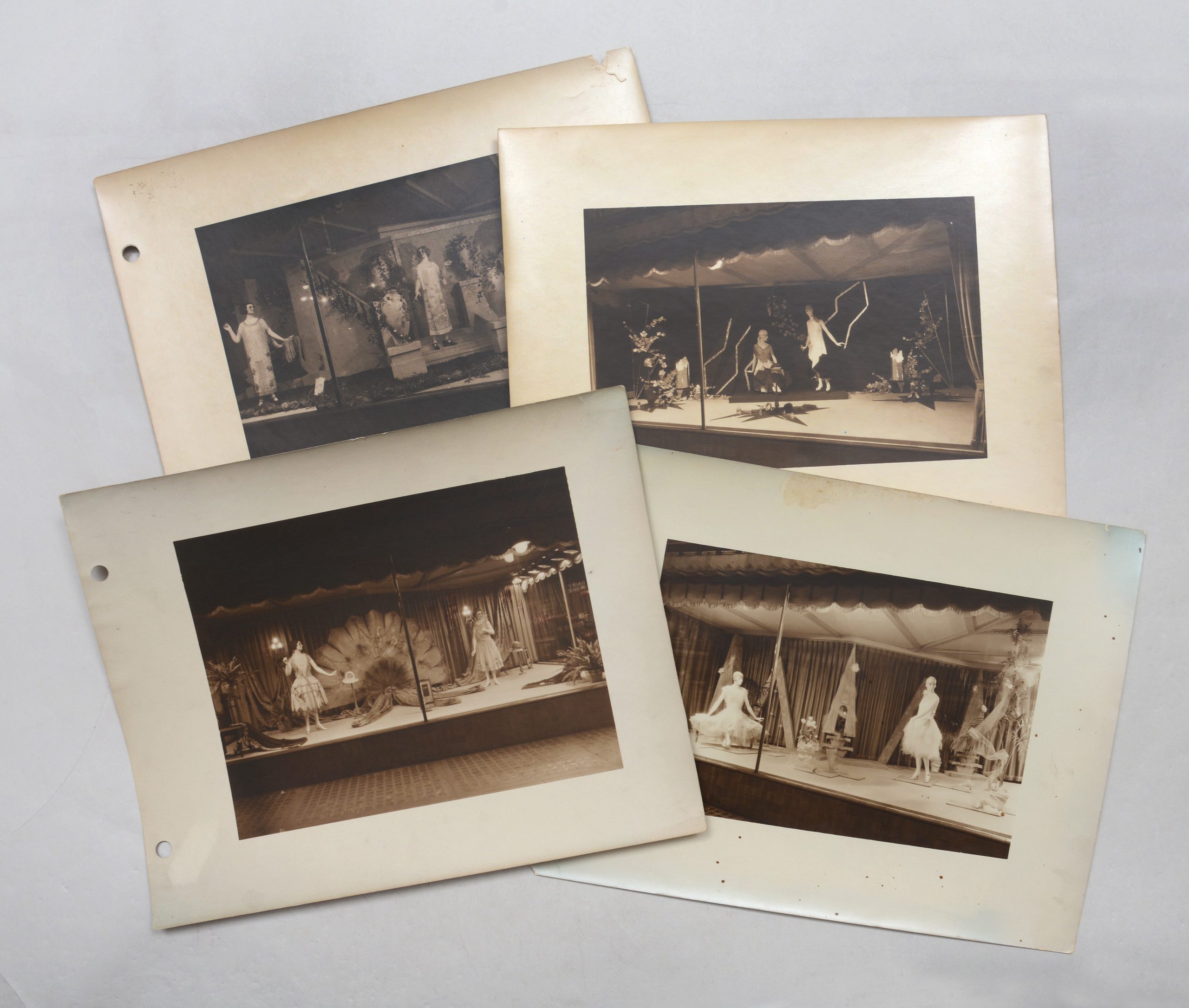43 Dover Street, Peter Harrington’s Mayfair shop, has a fashionable history. In the mid-20th Century it was owned by sisters Diana and Betty Pacquin; run as a chic boutique where bespoke outfits were created for genteel ladies. Though little more is known about their business at Dover Street, a Times editorial in 1938 describes a pair of the sisters’ designs, custom-made when they worked at Liberty London and worn to ‘the Second Court of the season’ at Buckingham Palace by a debutante and her mother. The article describes the Pacquins’ handiwork as showcased by its high-society wearers: one Mrs. R. S. Rait Kerr attended the ball in a shining gown of gold lamé, complete with a matching chiffon train; her daughter, Miss Diana Rait Kerr, donned an Empire gown of white matelassé and silver lamé, and a corsage laced with silver. The sisters, who were Jewish and adopted the surname Pacquin as a pseudonym, may have taken inspiration from the globally renowned French couturier, Jeanne Paquin, whose London premises was just down the road at 39 Dover Street.
Diana and Betty were continuing a tradition of high fashion at 43 Dover Street. In the 1920s it housed The Three Studios, a photography studio run by Yvonne Gregory and her husband, together with their friend and colleague Marcus Adams. A portrait and fashion photographer, as well as an artist, Yvonne also shot actresses, dancers and musicians, and produced several books of nude photography with her husband, Bertram Park.

The Three Photographers Studio at 43 Dover Street
Yvonne Gregory with her daughter June
Yvonne’s business card
(Many thanks to Sisters of the Lens, @sistersofthelens, for this information about Gregory and The Three Photographers, and for the use of these images)
In 1970, 43 Dover Street belonged to Hawkes & Curtis, which then owned two different shops for shirt making and tailoring (the other location in Burlington Gardens). On Dover Street, cutter Teddy Watson rivalled nearby Savile Row as he produced bespoke suits for the Prince of Wales. The tailors of Hawes & Curtis also catered to the likes of Frank Sinatra, Lucian Freud and Burt Lancaster in their time.
It seems apt, therefore, to have continued our Dover Street shop’s sartorial legacy with a dedicated catalogue of rare and unique fashion-related items. Below, we explore some of the highlights.
Queen Elizabeth II, Norman Hartnell
HARTNELL, Norman. Bespoke souvenir album containing Hartnell sketches for the Queen’s wardrobe for her State Visit to Paris, 1957. £4,000.00.
The late British fashion designer Norman Hartnell’s first royal commission was for the wedding gown of Princess Alice for her marriage to the Duke of Gloucester in 1935. But it was three years later that he established himself as one of the most revered couturiers of the day when, at the request of the King, he masterminded the outfits of the Queen’s state visit to France. His resulting designs received worldwide admiration and, soon after in 1940, Hartnell received his first royal warrant of appointment to the Queen (he would also be Dressmaker by Appointment to her daughter, Elizabeth II). His relationship with the royal family endured for over 40 years, conceiving some of the most famous gowns for royal women, including for Queen Elizabeth II’s Coronation and her wedding day, and Princess Margaret’s bridal dress in 1960. In 1977, he became a Knight Commander of the Royal Victorian Order, in recognition of his distinguished personal service to the monarch. Prudence Glenn, the then fashion editor of The Times, proclaimed Hartnell ‘The First Fashion Knight’.
Hartnell’s skill, which knew no bounds, is captured in this likely unique souvenir of Queen Elizabeth’s state visit to Paris in 1957. The work contains striking illustrations of Her Majesty’s fashion ensembles during the event, painstakingly rendered in ink and bold paints and accompanied by swatches of original fabrics and oval composites of the diverse accessories she wore.
Silver & Gold, Norman Hartnell
HARTNELL, Norman. Silver and Gold. 1955.
Norman Hartnell has received renewed global recognition for the Peau De Soie taffeta and diamanté-embellished dress worn by Princess Beatrice for her marriage to Edoardo Mopelli Mozzi this year. On loan from her grandmother, it was originally worn by Queen Elizabeth II for the film premiere of Lawrence in Arabia in London. Princess Eugenie, taking a modern and environmentally conscious approach, chose to contemporise Hartnell’s design for her wedding, adding organza puff sleeves and adjusting the hemline. The gown’s customisation was completed by two of Hartnell’s successors, designers Angela Kelly and Stewart Parvin. It is testament to his prowess that Hartnell’s work required such little adaptation – the piece has an exceptionally timeless aesthetic.
In this presentation copy of Silver & Gold, titled after his 1953 collection of over 100 gowns for guests at Elizabeth II’s coronation, Hartnell has inscribed a gift message to its recipient, Princess Mary: “To Her Royal Highness The Princess Royal. With respect, gratitude and humble best wishes at Christmastime. Norman Hartnell, Christmas 1955.” The first-edition book details the designer’s rise to the role of Dressmaker by Appointment to both Queen Elizabeth II and the Queen Mother, and offers intimate backgrounds to the fashion choices of a number of key royal appearances.
The Hat Shop, Constance Dorothy Evelyn Peel OBE
PEEL, Constance Dorothy Evelyn. The Hat Shop. 1914. £650.00.
According to a Times editorial, Constance Dorothy Peel OBE in “her industry was astonishing, for she went down coalmines, inspected prisons, reformatories and factories, examined schools and studied diet for the young, in addition to regular journalism and four novels … In Life’s Enchanted Cup … she made it clear that she worked out of necessity as well as pleasure: to provide for her two children, to support an aunt, and to save for her old age.” Peel, successful milliner, novelist, non-fiction author, autobiographer and journalist, is a rare example of a woman who was financially independent, enterprising in multiple industries and the sole provider for her family during the late 19th and early 20th centuries.
The unusual degree of autonomy Peel exercised is demonstrated by her decision to close her fashion business as a result of illness, as well as moral doubts about its value, and later pen her first novel, The Hat Shop, in 1914. She is an impressive historical figure. Despite her lack of childhood education and continuing health issues, she was an acclaimed writer of fiction and domestic guides, and investigative journalist focusing on social issues of the day; she later served on multiple government committees working to improve the lives of women in post-war Britain.
(DACHÉ, Lilly.) La Dépêche Directrice Andrée Vaudecrane; La note de Paris, directrice Gladys Capgras
(FASHION; DACHÉ, Lilly.) La Dépêche. 1949-50. £8,750.00.
Lilly Daché, America’s premier milliner during the 1940s, was a bold, ambitious and talented designer, and a wildly successful businesswoman. Born in Bègles, France, Daché trained as a milliner with her aunt in Bordeaux, as well as a dressmaker, and was eventually given an apprenticeship in Paris with designer Caroline Reboux, before going on to work for prestigious milliners Suzanne Talbot and Georgette. But Daché had set her sights on something bigger and, in 1924, moved to New York, where she was soon employed by a small hat shop, the Bonnet Shop, later purchasing it to start her own business. By the early ‘40s, Daché had an “elegant New York salon in which she employed 150 milliners, shops in Chicago and Miami, wholesale designs sold to more than forty stores across the country, and more than half a million dollars in business each year, selling hats priced from $35 to $500” (ANB). Quite a feat for just 15 years’ work.
Much like entrepreneurial fashion designers today, from Victoria Beckham to Rihanna, Daché recognised shifting markets and spearheaded several new ventures from the 1950s onwards: “she had completely revamped her salon and was designing, in addition to her own line of hats, dresses, accessories, jewellery, lingerie, furs, perfume, and cosmetics, plus men’s shirts and ties” (ibid.). Her commitment to an evolving enterprise is demonstrated by her continued subscription to and occasional highlighting of text in French fashion magazines, La Dépêche and La Note de Paris – collected here. Featuring the likes of Dior, Balenciaga and Balmain, as well as milliners Simone Cange and Madame Paulette, Daché’s faithful attention to these publications reflect her origins and identity as a cutting-edge French designer.
STEVENS, Charles O. & Max Sommers
STEVENS, Charles O. & Max Sommers. Photographs of Jazz Era Window Displays for Meier & Frank’s Department Store, Portland, OR. c.1925. £200.00.
These photographs are a genuine snapshot of history, transporting you to the time they were taken; seen through the eyes of a photographer who worked nearly 100 years ago. The four well-preserved images of 1925 window displays at the glamorous Meier & Frank’s Department Store in Portland, Oregon, offer a real glimpse of jazz-era fashion as it would have appealed to North American ladies at the time. They were taken just 15 years after the store first opened – the building, designed by prolific American architect A. E. Doyle, still stands today in downtown Portland.
The photographs offer an invaluable historical reference for how flapper fashions were marketed during the Jazz Age. Two of the window displays pictured include distinctive art deco themes with Ikebana-inspired flower arrangements amongst geometric display elements. The styles include typically ‘20s drop-waist hemlines and cocktail dresses with full skirts in chiffon. One image creates a fantastic formalised setting, incorporating a large French Madame Pompadour-style fan in the background with heavy brocade swags, interspersed with large asparagus ferns in jardinières; another, identified as “Spring” on a small placard, includes an Italianate garden terrace setting with amphorae and rose-twined balusters.
This selection of items comes from our recent Fashion e-list. The list consists of a remarkable gathering of books and ephemera which trace the history and development of fashion and design from the early 19th century to the modern day.
Encompassing such topics as high street window displays, haute couture tailoring, handicrafts, the theory of weaving, costume design and wallpaper fashions, it also aims to highlight some of the crucial hidden skills behind the fashion industry, such as tracing the history of pattern-cutting, and key texts for weaving, dying, and boot-making.
This interactive catalogue has been created to be both mobile and desktop friendly, and to bring to life some of the extraordinary items from our shelves. We welcome feedback on your experience.





